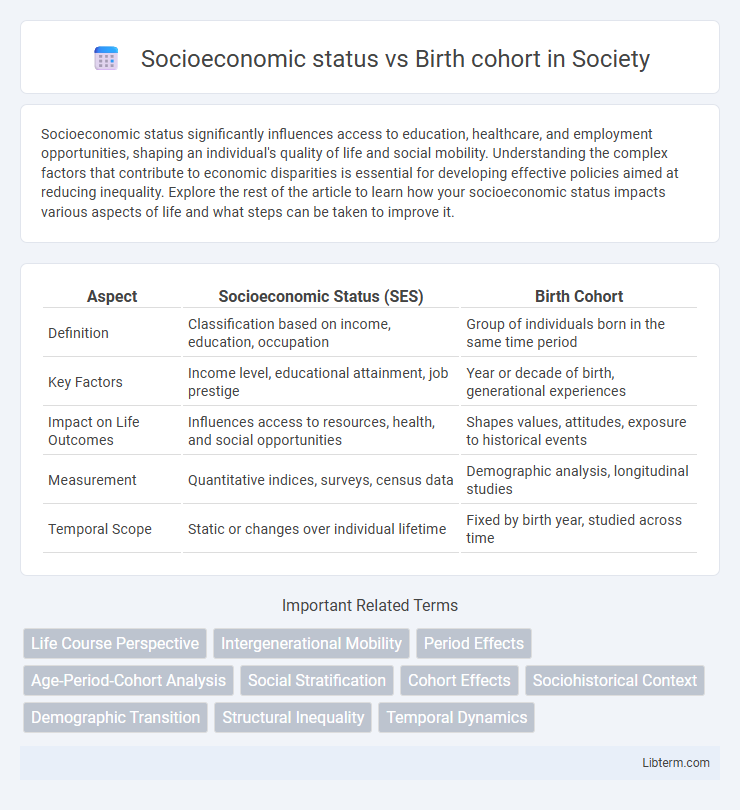Socioeconomic status significantly influences access to education, healthcare, and employment opportunities, shaping an individual's quality of life and social mobility. Understanding the complex factors that contribute to economic disparities is essential for developing effective policies aimed at reducing inequality. Explore the rest of the article to learn how your socioeconomic status impacts various aspects of life and what steps can be taken to improve it.
Table of Comparison
| Aspect | Socioeconomic Status (SES) | Birth Cohort |
|---|---|---|
| Definition | Classification based on income, education, occupation | Group of individuals born in the same time period |
| Key Factors | Income level, educational attainment, job prestige | Year or decade of birth, generational experiences |
| Impact on Life Outcomes | Influences access to resources, health, and social opportunities | Shapes values, attitudes, exposure to historical events |
| Measurement | Quantitative indices, surveys, census data | Demographic analysis, longitudinal studies |
| Temporal Scope | Static or changes over individual lifetime | Fixed by birth year, studied across time |
Defining Socioeconomic Status and Birth Cohort
Socioeconomic status (SES) is a composite measure that typically includes income, education, and occupation, reflecting an individual's social and economic position relative to others. Birth cohort refers to a group of individuals born during a specific time period, often studied to examine the effects of historical and social changes on health and behavior. Understanding the interaction between SES and birth cohort helps reveal how economic and social conditions over time influence life outcomes and disparities.
The Interplay Between Socioeconomic Status and Generational Differences
Socioeconomic status (SES) significantly influences health outcomes and educational attainment across different birth cohorts, revealing shifting patterns of inequality over time. Birth cohorts experience varying social, economic, and policy environments that modify how SES impacts opportunities and life trajectories, with younger generations often facing new challenges like wage stagnation and changing labor markets. Understanding the interplay between SES and generational differences is critical for designing targeted interventions that address structural disadvantages unique to each cohort.
Impact of Socioeconomic Status on Life Opportunities
Socioeconomic status (SES) significantly shapes life opportunities across different birth cohorts, influencing access to education, healthcare, and employment. Higher SES often correlates with improved cognitive development and long-term health outcomes, resulting in greater social mobility. Disparities in SES across cohorts highlight persistent inequality, underscoring the role of economic resources in shaping generational prospects.
Birth Cohorts: Characteristics and Historical Contexts
Birth cohorts are groups of individuals born during the same period, often sharing distinct socioeconomic environments shaped by their historical context, such as economic recessions, technological advancements, or social policies. These cohorts experience varying opportunities and constraints that influence their education, employment, and health outcomes, resulting in different socioeconomic trajectories over their lifespans. Understanding birth cohort characteristics enables researchers to analyze how historical events and social changes impact socioeconomic status across generations.
Educational Attainment Across Socioeconomic and Cohort Lines
Educational attainment varies significantly across socioeconomic status and birth cohorts, with individuals from higher socioeconomic backgrounds consistently achieving higher levels of education. Analysis of birth cohorts reveals that more recent generations show increased educational attainment overall, though disparities persist based on socioeconomic factors. These trends highlight the enduring influence of socioeconomic status on educational opportunities despite cohort-wide improvements.
Employment Trends: A Comparative Analysis
Employment trends reveal significant disparities when analyzing socioeconomic status across different birth cohorts, highlighting persistent inequality in job stability and income growth. Higher socioeconomic status groups typically experience earlier and more sustained employment, while lower status cohorts face increased job insecurity and unemployment rates. These patterns indicate that socioeconomic position strongly influences workforce participation and economic mobility throughout successive generations.
Health Outcomes Influenced by SES and Birth Cohort
Socioeconomic status (SES) and birth cohort significantly influence health outcomes, with individuals from lower SES backgrounds experiencing higher risks of chronic diseases and reduced life expectancy across generations. Variations in health behaviors, access to healthcare, and environmental exposures within different birth cohorts further compound disparities, making the interaction between SES and birth cohort a critical factor in shaping population health trends. Research indicates that improvements in SES over successive birth cohorts often correlate with better health outcomes, highlighting the importance of addressing socioeconomic inequalities to promote equitable health across lifespan.
Technology Adoption: SES vs. Generational Influence
Socioeconomic status significantly impacts technology adoption, with higher SES groups exhibiting earlier and more frequent uptake of new technologies due to greater access to resources and education. Birth cohorts reflect generational influences, where younger generations, regardless of SES, tend to adopt technology faster because of digital nativity and cultural exposure. The interplay between SES and birth cohort shapes technology adoption patterns, highlighting disparities driven by both economic means and generational experience.
Policy Implications: Addressing SES and Cohort Disparities
Targeted policies addressing socioeconomic status (SES) and birth cohort disparities can reduce long-term inequality by improving access to education, healthcare, and employment opportunities for disadvantaged groups. Implementing cohort-specific interventions, such as early childhood programs and lifelong learning initiatives, helps mitigate the cumulative effects of SES over time. Policymakers should prioritize resource allocation to vulnerable cohorts to foster social mobility and economic resilience across generations.
Future Research Directions on SES and Birth Cohorts
Future research on socioeconomic status (SES) and birth cohorts should prioritize longitudinal studies that capture dynamic SES changes across the lifespan and their differential impacts on health and social outcomes. Integrating advanced statistical methods to disentangle cohort effects from period and age effects will enhance causal inferences about SES trajectories and generational disparities. Expanding diverse population samples and incorporating genetic, environmental, and policy variables will provide a comprehensive understanding of how SES shapes life course outcomes across birth cohorts.
Socioeconomic status Infographic

 libterm.com
libterm.com